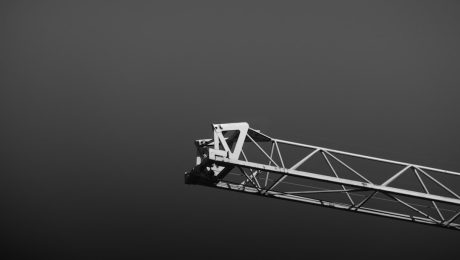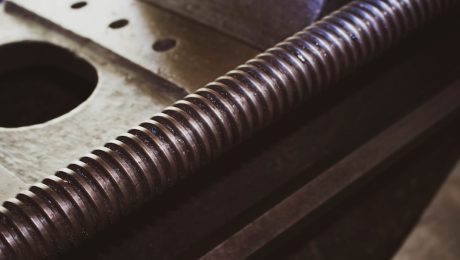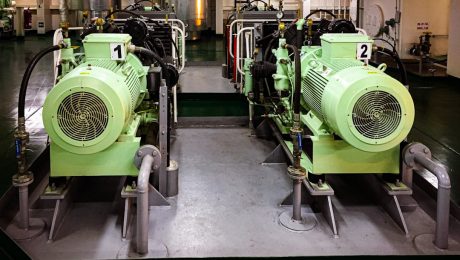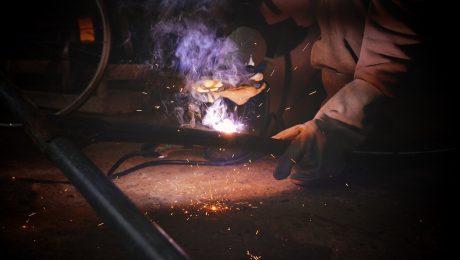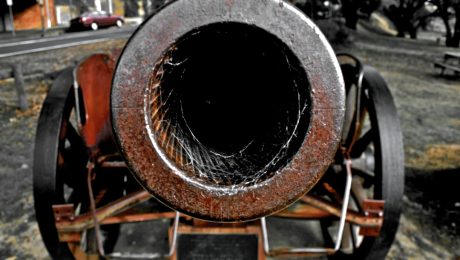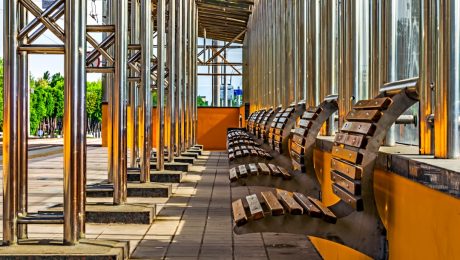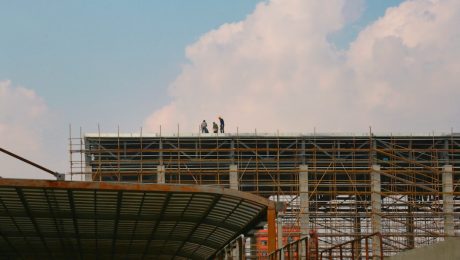The steel industry, a cornerstone of global infrastructure and manufacturing, faces a critical challenge: decarbonization. Producing steel traditionally relies on blast furnaces fueled by coal, resulting in significant greenhouse gas emissions. However, the urgent need to mitigate climate change is pushing the industry towards ambitious net-zero targets, demanding innovative solutions and a fundamental shift in production methods. This post explores the complexities and exciting advancements in the pursuit of net-zero steel.
The Urgency of Net-Zero Steel: Why It Matters
The steel industry accounts for approximately 7% of global greenhouse gas emissions. This substantial contribution necessitates immediate and drastic action to align with global climate goals. Failure to decarbonize the steel sector will severely hinder efforts to limit global warming to 1.5°C, as outlined in the Paris Agreement. Beyond the environmental imperative, achieving net-zero also presents significant economic opportunities, driving innovation, creating new jobs in green technologies, and enhancing the industry’s global competitiveness. Consumers are increasingly demanding sustainable products, putting pressure on steel manufacturers to adopt eco-friendly practices and demonstrate a commitment to reducing their carbon footprint.
Hydrogen-Based Steelmaking: A Promising Pathway to Decarbonization
One of the most promising avenues towards net-zero steel is the transition to hydrogen-based steelmaking. Traditional blast furnaces rely on coking coal for both heat and reducing iron ore. Hydrogen, however, can replace coal as the reducing agent, eliminating direct CO2 emissions from the process. Different approaches are being explored, including the direct reduction of iron ore with hydrogen (DRI) and the use of hydrogen in electric arc furnaces (EAFs). While hydrogen-based steelmaking is still in its developmental stages, significant progress is being made, with several pilot projects demonstrating its feasibility and potential. The key challenge lies in securing a sustainable and affordable supply of green hydrogen, produced from renewable energy sources.
Carbon Capture, Utilization, and Storage (CCUS): A Complementary Technology
While hydrogen-based steelmaking offers a pathway to eliminate direct CO2 emissions, carbon capture, utilization, and storage (CCUS) technologies can play a crucial role in mitigating emissions from existing and transitional steelmaking processes. CCUS involves capturing CO2 emissions from blast furnaces or other steelmaking sources, transporting them, and either storing them underground or utilizing them in other industrial processes. While CCUS is not a standalone solution and is energy-intensive, it can provide a valuable bridge to a fully decarbonized steel industry, reducing emissions from existing infrastructure while new technologies are developed and scaled up. The economic viability and scalability of CCUS remain important considerations.
The Role of Renewable Energy and Electricity in Green Steel Production
The shift to net-zero steel is intrinsically linked to the transition to renewable energy sources. Producing green hydrogen requires substantial amounts of renewable electricity, such as solar and wind power. Furthermore, electric arc furnaces (EAFs), which are already a more energy-efficient alternative to blast furnaces, will become increasingly important in a decarbonized steel industry. The increased reliance on electricity necessitates a significant expansion of renewable energy infrastructure and the development of smart grids to manage the fluctuating nature of renewable energy sources. Investing in grid modernization and energy storage solutions will be crucial for supporting the decarbonization of the steel industry.
Overcoming Challenges and Accelerating the Transition to Net-Zero Steel
The transition to net-zero steel faces significant challenges, including the high capital costs associated with new technologies, the need for large-scale infrastructure development, and the complexities of integrating new processes into existing steelmaking facilities. Policy support, including carbon pricing mechanisms, government incentives for green technologies, and regulatory frameworks promoting sustainable steel production, will be crucial in accelerating the transition. Collaboration between steel manufacturers, technology providers, research institutions, and policymakers is essential to overcome these challenges and ensure a just and equitable transition that protects jobs and promotes economic growth. Furthermore, the development of standardized metrics and certification schemes for green steel will enhance transparency and consumer confidence.
The journey towards net-zero steel is ambitious but essential. By embracing innovative technologies, fostering collaboration, and implementing supportive policies, the steel industry can forge a greener future, reducing its environmental impact while maintaining its vital role in global economic development.
body {
font-family: sans-serif;
line-height: 1.6;
}
h1, h2 {
color: #333;
}
The word “round” seems deceptively simple. We use it casually, describing objects from coins to planets. But a closer look reveals a concept rich in mathematical precision, cultural symbolism, and practical applications. This exploration delves into the multifaceted world of “round,” uncovering its surprising depth and enduring influence.
The Mathematical Definition of Round: Circles and Spheres
In mathematics, “round” primarily refers to the geometric shapes of the circle and the sphere. A circle is a two-dimensional shape defined as the set of all points equidistant from a central point (the center). Its defining characteristic is its constant radius, leading to a perfectly symmetrical form. Key aspects of a circle include its circumference (the distance around it), its diameter (the distance across it through the center), and its area (the space it encloses). The relationship between these elements is governed by the constant π (pi), approximately 3.14159, a fundamental number in mathematics.
A sphere is the three-dimensional equivalent of a circle. It’s a perfectly round three-dimensional object, with all points on its surface equidistant from a central point. Similar to a circle, a sphere’s properties, such as its surface area and volume, are calculated using π and its radius.
Round in Nature: From Planetary Orbits to Cellular Structures
The round shape is prevalent throughout the natural world. Planetary orbits, while not perfectly circular, are often approximated as ellipses – slightly elongated circles. The spherical shape of planets and stars is a consequence of gravity, pulling matter equally in all directions. The roundness of raindrops is a result of surface tension minimizing the surface area for a given volume. Even at the microscopic level, many biological structures exhibit roundness, from cells to some types of pollen.
This prevalence of round shapes in nature highlights its efficiency and stability. The spherical form is often optimal for minimizing surface area and maximizing volume, which is advantageous in various biological and physical processes. The perfect symmetry of a sphere or circle also contributes to its structural integrity.
The Cultural Symbolism of Roundness: Completeness and Infinity
Beyond its mathematical and scientific significance, “round” holds profound cultural and symbolic meaning across various societies. In many cultures, the circle represents wholeness, completeness, and infinity. Its continuous, unbroken form symbolizes the cyclical nature of life, death, and rebirth. The mandala, a spiritual and ritual symbol in Hinduism and Buddhism, often takes the form of a complex, geometrically intricate circle, representing the universe and the interconnectedness of all things.
Round objects have been used in rituals and ceremonies for centuries. The use of round stones, beads, and other objects in religious practices underscores the symbolic importance of this shape. The circular arrangement of participants in some ceremonies further reinforces the sense of unity and completeness.
Round in Design and Technology: From Wheels to Lenses
The round shape plays a crucial role in design and technology. The invention of the wheel, arguably one of humanity’s most significant technological advancements, revolutionized transportation and many other aspects of life. Its circular form allows for efficient rolling motion, minimizing friction and maximizing distance traveled with minimal energy expenditure.
Round shapes are also prevalent in optics and other areas of physics. Lenses, for example, often utilize spherical or circular surfaces to focus or refract light. The circular nature of these surfaces allows for even distribution of light, leading to sharper images. The design of many mechanical parts and components also leverages the strength and efficiency of round shapes.
Beyond the Obvious: Exploring Variations on the Round Theme
While we often think of “round” as perfectly circular or spherical, many objects exhibit a degree of roundness without being perfectly so. Ellipses, for instance, are elongated circles, still possessing a degree of symmetry and roundness. Ovals and other irregular shapes might also be described as “roundish” depending on their overall form and the context in which they’re discussed. Even the seemingly straight lines of a building might incorporate curved elements that contribute to a sense of roundness in the overall design.
Understanding the nuances of “roundness” involves considering the degree of symmetry, the regularity of the curve, and the context in which the shape is being used. It’s not just about perfect mathematical definitions; it’s also about the perception and interpretation of form.
The seemingly simple concept of “round” reveals a surprising complexity when examined closely. From its mathematical foundations to its cultural symbolism and practical applications, “round” continues to shape our understanding of the world around us.
Tags: round, circle, sphere, geometry, symbolism
Modular steel system solutions are revolutionizing the construction industry, offering a compelling alternative to traditional building methods. Their inherent flexibility, speed of construction, and cost-effectiveness are driving their adoption across various sectors, from industrial facilities to commercial spaces and even residential projects. This comprehensive guide delves into the key aspects of these innovative systems, exploring their benefits and applications.
1. Design Flexibility: Tailoring Steel Systems to Your Needs
One of the most significant advantages of modular steel systems is their unparalleled design flexibility. Unlike traditional construction, where design changes can be costly and time-consuming, modular steel allows for significant customization. Pre-engineered components can be easily adapted to meet specific requirements, whether it’s altering the size, shape, or functionality of a building. This flexibility extends to incorporating various architectural styles and finishes, ensuring the final structure seamlessly integrates with its surroundings. Furthermore, the ability to easily add or remove modules allows for future expansion or modification, making these systems highly adaptable to changing needs over time. This adaptability is particularly crucial for businesses anticipating growth or those needing to respond to evolving market demands.
2. Cost-Effectiveness: Streamlining Construction with Modular Steel
Modular steel systems offer significant cost savings compared to traditional construction methods. The prefabrication process, taking place in a controlled factory environment, reduces labor costs, material waste, and on-site construction time. This efficiency translates directly into lower overall project expenses. Furthermore, the precision of prefabrication minimizes errors and rework, further contributing to cost savings. The reduced construction time also means faster project completion, allowing businesses to start operations sooner and generate revenue more quickly. This accelerated timeline also minimizes financing costs and potential delays associated with weather or labor shortages, further enhancing the cost-effectiveness of modular steel solutions.
3. Speed of Construction: Accelerated Project Delivery with Modular Systems
The prefabricated nature of modular steel systems dramatically accelerates construction timelines. While traditional construction involves sequential processes that often overlap, modular construction allows for parallel workstreams. Modules are fabricated concurrently, and once ready, they are swiftly transported and assembled on-site. This parallel approach significantly reduces the overall construction time, often by 30-50% compared to traditional methods. This speed is a critical advantage for businesses eager to occupy their new facilities quickly, minimizing downtime and maximizing operational efficiency. The accelerated delivery also minimizes disruption to surrounding areas, making modular steel a suitable solution for projects in densely populated urban environments.
4. Sustainability: Eco-Friendly Construction with Modular Steel
Modular steel systems offer a sustainable approach to construction. The precision of prefabrication minimizes material waste, reducing the environmental impact associated with construction debris. Steel itself is a highly recyclable material, contributing to the overall sustainability of the system. Furthermore, the controlled factory environment reduces the amount of energy consumed during construction, minimizing the carbon footprint. Many modular steel solutions also incorporate sustainable building materials and design principles, such as energy-efficient windows and insulation, further enhancing their environmental credentials. The ability to easily adapt and repurpose modules contributes to the longevity of the structures, reducing the need for demolition and new construction in the long term.
5. Applications and Versatility: Modular Steel Across Diverse Industries
Modular steel system solutions find applications across a wide range of industries and project types. Their versatility makes them suitable for:
- Industrial buildings: Warehouses, factories, and manufacturing plants benefit from the strength, durability, and flexibility of modular steel.
- Commercial buildings: Offices, retail spaces, and restaurants can be efficiently constructed using modular steel, offering design flexibility and cost-effectiveness.
- Residential buildings: Modular steel is increasingly used in the construction of apartments, townhouses, and even single-family homes, providing a fast and efficient building process.
- Educational facilities: Schools and universities can leverage modular steel to create adaptable learning spaces that can be easily expanded or reconfigured as needed.
- Healthcare facilities: Modular steel can be used to construct temporary or permanent healthcare structures, providing a rapid response to healthcare needs in emergency situations or for expanding existing facilities.
The adaptability of modular steel systems allows them to meet the unique requirements of each project, making them a truly versatile construction solution.
In conclusion, modular steel system solutions offer a compelling combination of design flexibility, cost-effectiveness, speed of construction, and sustainability. Their versatility makes them suitable for a wide range of projects, driving their increasing adoption across various industries. By embracing this innovative approach to construction, businesses and organizations can unlock significant advantages in terms of efficiency, cost savings, and environmental responsibility.
SEO Tags:
- Modular Steel
- Prefabricated Steel Buildings
- Steel System Solutions
- Modular Construction
- Sustainable Steel Buildings
The steel industry is constantly evolving, pushing the boundaries of material science to create products with enhanced properties and capabilities. High value-added steel products represent the pinnacle of this evolution, offering superior performance, durability, and specialized functionalities that are crucial for numerous advanced applications. This comprehensive guide delves into the fascinating world of these specialized steels, exploring their characteristics, manufacturing processes, and diverse applications.
1. Defining High Value-Added Steel: Beyond the Basic Grade
Unlike standard steel grades used in mass-produced items, high value-added steel products undergo extensive processing and refinement. This involves sophisticated techniques aimed at enhancing specific properties, such as strength, corrosion resistance, formability, and weldability. These enhancements translate to improved performance in demanding environments and applications where ordinary steel would fall short. The “value-added” aspect stems from the increased cost of production due to the complex processes involved, but this is often justified by the superior performance and longevity of the final product. Examples include advanced high-strength steels (AHSS), stainless steels with enhanced corrosion resistance, and tool steels with exceptional wear resistance.
2. Manufacturing Processes: Precision and Innovation
The creation of high value-added steel involves a meticulous series of processes extending beyond basic steelmaking. These often include:
- Controlled Rolling and Cooling: Precise control over the cooling rate during rolling significantly influences the microstructure and thus the final properties of the steel.
- Thermomechanical Processing (TMP): TMP combines controlled deformation and heat treatments to achieve optimal microstructures and mechanical properties.
- Alloying: The addition of specific alloying elements (e.g., chromium, nickel, molybdenum) enhances corrosion resistance, strength, and other desired properties.
- Surface Treatments: Processes like galvanizing, coating, and nitriding improve corrosion resistance, wear resistance, and surface hardness.
- Advanced Forming Techniques: Techniques such as hydroforming and precision forging allow for the creation of complex shapes and precise tolerances.
The precision and control required in these processes are crucial for achieving the desired properties and ensuring consistency in the final product.
3. Applications Across Industries: Where High Performance Meets Demand
The superior characteristics of high value-added steel products make them indispensable in a wide range of industries. Some key applications include:
- Automotive Industry: AHSS is extensively used in automotive body panels and structural components to improve fuel efficiency, safety, and crashworthiness.
- Aerospace Industry: High-strength, lightweight steels are crucial in aircraft construction to reduce weight and improve fuel consumption.
- Energy Sector: Corrosion-resistant stainless steels are essential in pipelines, storage tanks, and power generation equipment.
- Medical Devices: Biocompatible stainless steels are used in surgical instruments, implants, and other medical devices.
- Construction Industry: High-strength steels are used in skyscrapers, bridges, and other large-scale structures to enhance durability and load-bearing capacity.
The versatility and performance of high value-added steels are continuously driving innovation and advancements across these sectors.
4. Market Trends and Future Outlook: A Growing Demand
The market for high value-added steel products is experiencing significant growth, driven by increasing demand from various industries. Key trends include:
- Lightweighting Initiatives: The push for lighter vehicles and aircraft is driving demand for high-strength, low-density steels.
- Enhanced Sustainability: The industry is focusing on developing more sustainable steel production processes with reduced environmental impact.
- Advanced Materials Research: Continuous research and development efforts are leading to new steel grades with even more enhanced properties.
- Globalization and Trade: International trade plays a significant role in the global market for high value-added steel.
The future outlook for high value-added steel is promising, with continued growth expected as technology advances and demand from diverse sectors increases.
5. Challenges and Opportunities: Navigating the Future of Steel
Despite the promising outlook, the high value-added steel industry faces certain challenges. These include:
- High Production Costs: The sophisticated manufacturing processes involved can lead to higher production costs compared to standard steel grades.
- Raw Material Availability: The availability and cost of specific alloying elements can impact production costs and efficiency.
- Technological Advancements: Keeping pace with rapid technological advancements and integrating new technologies into production processes is crucial.
- Sustainability Concerns: Minimizing the environmental impact of steel production is a growing concern that requires innovative solutions.
However, these challenges also present opportunities for innovation and development, leading to more sustainable, cost-effective, and high-performance steel products in the future.
In conclusion, high value-added steel products represent a significant advancement in materials science, offering unparalleled performance and capabilities across a wide range of applications. As technology continues to evolve and demand increases, the importance of these specialized steels in shaping the future of various industries will only grow stronger.
Tags: High Value-Added Steel, Advanced High-Strength Steel (AHSS), Specialty Steel, Steel Manufacturing, Steel Applications
Industrial machinery relies heavily on efficient and reliable fluid transfer systems. These systems, often overlooked, are the backbone of countless processes, from chemical manufacturing to power generation. The unsung heroes of these systems? Pipes. This comprehensive guide delves into the critical role of pipe usage in industrial machinery, exploring various aspects from material selection to safety protocols.
1. Material Selection: Choosing the Right Pipe for the Job
The choice of pipe material is paramount. It directly impacts the lifespan, safety, and overall efficiency of the system. Several factors influence this decision, including the fluid being transported, operating temperature and pressure, and the corrosive environment. Common materials include:
- Carbon Steel: A versatile and cost-effective option for many applications, particularly those involving water, steam, or non-corrosive fluids. However, it’s susceptible to corrosion in certain environments.
- Stainless Steel: Offers superior corrosion resistance, making it ideal for handling aggressive chemicals and high-purity fluids. Different grades of stainless steel (e.g., 304, 316) offer varying degrees of corrosion resistance.
- Cast Iron: Used in applications requiring high pressure and durability, but it’s heavier and more prone to corrosion than steel.
- Plastic Pipes (PVC, CPVC, HDPE): Lightweight, corrosion-resistant, and cost-effective for handling chemicals and other non-aggressive fluids. However, they may have limitations regarding temperature and pressure resistance.
- Copper: Excellent corrosion resistance and thermal conductivity, often used in plumbing and HVAC systems.
Selecting the wrong material can lead to leaks, corrosion, and even catastrophic failures, highlighting the importance of careful consideration during the design phase.
2. Pipe Fittings and Connections: Ensuring Leak-Free Systems
Pipes rarely run in straight lines. Fittings, such as elbows, tees, and flanges, are essential for directing fluid flow and creating complex piping networks. The choice of fitting and connection method depends on factors such as pressure, temperature, and the pipe material. Common connection methods include:
- Threaded Connections: Relatively simple and cost-effective, suitable for lower pressure applications. Require careful sealing to prevent leaks.
- Flanged Connections: Robust and suitable for high-pressure applications. Allow for easier disassembly and maintenance.
- Welding: Creates a permanent and leak-proof connection, ideal for high-pressure and critical applications. Requires skilled welders and adherence to strict quality control procedures.
- Compression Fittings: Easy to install and suitable for lower pressure applications. Often used with plastic pipes.
Proper installation and maintenance of fittings are crucial for preventing leaks and ensuring the integrity of the entire piping system. Regular inspection and timely replacement of worn or damaged fittings are essential for safety and operational efficiency.
3. Pipe Sizing and Flow Calculations: Optimizing Fluid Transfer
Accurate pipe sizing is critical for efficient fluid transfer. Undersized pipes can lead to increased pressure drop, reduced flow rate, and increased energy consumption. Oversized pipes are wasteful and may not be suitable for the required pressure. Hydraulic calculations, using formulas and software, are employed to determine the appropriate pipe diameter based on factors like flow rate, fluid viscosity, and desired pressure drop. These calculations ensure the system operates within its design parameters, maximizing efficiency and minimizing energy waste.
4. Pipe Support and Stress Mitigation: Preventing Failures
Pipes, especially those carrying fluids under high pressure or temperature, are subject to significant stress. Inadequate support can lead to sagging, vibration, and ultimately, pipe failure. Proper pipe support systems, including hangers, clamps, and restraints, are crucial for distributing the weight and stress evenly. These systems must be designed to accommodate thermal expansion and contraction, preventing undue stress on the pipes and connections. Regular inspection and maintenance of the support system are vital to ensure the long-term integrity of the piping network.
5. Safety and Maintenance: Ensuring Long-Term Reliability
Safety is paramount in industrial settings. Properly designed, installed, and maintained piping systems are crucial for preventing leaks, spills, and other hazards. Regular inspections, including visual checks, pressure testing, and non-destructive testing (NDT) methods, are essential for identifying potential problems early on. A comprehensive maintenance program, including scheduled inspections and repairs, helps ensure the long-term reliability and safety of the piping system. This also includes implementing appropriate safety protocols for workers during installation, maintenance, and repair operations.
In conclusion, the seemingly simple pipe plays a vital role in the functionality and safety of industrial machinery. Understanding the nuances of pipe selection, installation, and maintenance is crucial for optimizing performance, ensuring safety, and minimizing downtime. By addressing these aspects diligently, industries can ensure the smooth and efficient operation of their machinery for years to come.
Tags: industrial piping, industrial pipes, pipe usage, machinery pipes, pipe maintenance
Choosing the right steel supplier is crucial for any business relying on steel for its operations. A poor choice can lead to delays, compromised quality, increased costs, and even project failures. This comprehensive guide will walk you through the key factors to consider when evaluating potential steel suppliers, empowering you to make informed decisions and build strong, reliable partnerships.
1. Assessing Steel Quality and Certifications
The cornerstone of any successful steel procurement strategy is ensuring consistent, high-quality steel. Begin your evaluation by rigorously scrutinizing the supplier’s quality control processes. Request copies of their quality management system (QMS) documentation, ideally ISO 9001 certified. This demonstrates their commitment to standardized procedures and continuous improvement. Beyond ISO 9001, look for specific certifications relevant to your industry and the type of steel you require. This might include certifications related to specific material properties, such as tensile strength, yield strength, or chemical composition. Don’t hesitate to request mill test reports (MTRs) for specific batches of steel to verify the material conforms to the specified standards. Requesting samples for independent testing can provide further assurance of quality.
2. Evaluating Supplier Reliability and Capacity
Reliability is paramount. A supplier’s ability to consistently deliver on time and in full is critical to maintaining your project timelines and avoiding costly delays. Investigate the supplier’s track record. Request references from previous clients and check online reviews. Inquire about their order fulfillment history, lead times, and on-time delivery rates. Assess their production capacity to ensure they can meet your current and future demands. A supplier with insufficient capacity might struggle to meet your needs during peak periods, leading to potential shortages. Consider the supplier’s geographical location and its proximity to your facilities. Shorter distances translate to lower transportation costs and reduced lead times. Also, consider their inventory management system – a well-managed inventory minimizes the risk of delays due to stockouts.
3. Analyzing Pricing and Payment Terms
Cost is a significant factor, but it shouldn’t be the sole determinant. While seeking competitive pricing is essential, avoid focusing solely on the lowest price. A cheaper supplier might compromise on quality or reliability, ultimately costing you more in the long run. Request detailed quotes that clearly outline all costs, including transportation, handling fees, and potential surcharges. Negotiate favorable payment terms that align with your cash flow. Explore options like early payment discounts or extended payment periods, depending on the supplier’s willingness to negotiate. Be wary of suppliers who are significantly undercutting competitors, as this could indicate potential quality issues or unsustainable pricing practices.
4. Understanding Supplier Technology and Infrastructure
A modern and well-equipped steel supplier utilizes advanced technologies to ensure efficiency and quality. Inquire about their manufacturing processes, equipment, and testing facilities. A supplier investing in modern technology is likely to produce higher-quality steel more efficiently. Their infrastructure should also be assessed – are their facilities well-maintained and capable of handling large orders? Do they have adequate storage capacity to prevent material degradation? Understanding their technological capabilities and infrastructure provides insights into their commitment to quality and efficiency, ultimately impacting the reliability and quality of the steel you receive.
5. Establishing Strong Communication and Collaboration
Effective communication is crucial for a successful supplier-customer relationship. Assess the supplier’s responsiveness and communication channels. Do they have dedicated account managers? How quickly do they respond to inquiries and address concerns? A responsive and communicative supplier ensures smooth collaboration and efficient problem-solving. Regular communication helps prevent misunderstandings and ensures that both parties are on the same page regarding orders, delivery schedules, and potential issues. Establishing a strong working relationship built on trust and open communication is essential for long-term success.
By carefully evaluating potential steel suppliers based on these five key areas – quality, reliability, pricing, technology, and communication – you can significantly reduce the risks associated with steel procurement and build a strong foundation for a successful partnership. Remember that thorough due diligence is essential to ensure you are selecting a supplier that meets your specific needs and contributes to the overall success of your projects.
SEO-Friendly Tags:
- Steel Supplier Evaluation
- Choosing a Steel Supplier
- Steel Quality Control
- Steel Procurement Strategy
- Reliable Steel Suppliers
body { font-family: sans-serif; line-height: 1.6; }
h1, h2, h3 { color: #333; }
img { max-width: 100%; height: auto; }
In the world of construction and plumbing, the choice of piping material significantly impacts the longevity and efficiency of a project. While various options exist, galvanized steel pipes continue to hold a prominent position due to their exceptional durability and cost-effectiveness. This comprehensive guide delves into the numerous advantages of galvanized pipes, helping you understand why they remain a popular choice for both residential and commercial applications.
Unmatched Durability and Longevity: The Strength of Galvanized Steel
Galvanized pipes are made from steel that has undergone a process called galvanization. This involves coating the steel with a protective layer of zinc. This zinc coating is what provides the pipe with its exceptional durability and resistance to corrosion. Unlike many other materials, galvanized steel can withstand significant pressure and impact, making them ideal for various applications, from underground water lines to high-pressure industrial systems. Their robust nature ensures a long lifespan, often exceeding decades with proper installation and maintenance. This longevity translates to reduced replacement costs and less disruption over the years, a significant advantage in both the short and long term.
Superior Corrosion Resistance: Protecting Against the Elements
One of the most significant benefits of galvanized pipes is their remarkable resistance to rust and corrosion. The zinc coating acts as a sacrificial anode, meaning it reacts with oxygen and moisture in the environment before the underlying steel can. This prevents the formation of rust, which weakens the pipe and can lead to leaks and failures. This corrosion resistance is particularly crucial in areas with high humidity, harsh weather conditions, or soil with a high acidity level. Galvanized pipes can effectively withstand these environmental challenges, ensuring the integrity of your plumbing system for years to come. This characteristic also makes them suitable for both indoor and outdoor applications.
Cost-Effective Solution: Balancing Quality and Affordability
While the initial cost of galvanized pipes might seem slightly higher than some other materials like PVC, the long-term cost-effectiveness is undeniable. Their exceptional durability and longevity translate to significantly reduced replacement and repair costs over the lifespan of the pipe. Furthermore, the ease of installation compared to some other materials, like copper, often leads to lower labor costs. The combination of durability, longevity, and relatively low installation costs makes galvanized pipes a financially sound investment for both homeowners and large-scale construction projects. This makes them a particularly attractive option when budgetary constraints are a concern.
Versatile Applications: From Homes to Industries
The versatility of galvanized pipes is another key advantage. They are suitable for a wide range of applications, from residential plumbing systems supplying water to homes to industrial settings handling high-pressure fluids. Their strength and corrosion resistance allow them to be used in underground installations, above-ground piping, and even in harsh environments. This adaptability makes them a valuable asset for various construction projects, eliminating the need for multiple types of pipes and simplifying the overall installation process. From simple domestic water supply to complex industrial processes, galvanized pipes can reliably handle the demands.
Easy Installation and Maintenance: Simplifying the Process
Galvanized pipes are relatively straightforward to install, requiring standard plumbing techniques and tools. Their robust nature makes them easy to handle and connect, reducing installation time and labor costs. Moreover, their durability reduces the need for frequent maintenance and repairs. Simple inspections and occasional cleaning are often sufficient to ensure the long-term performance of the system. The ease of installation and minimal maintenance requirements contribute to the overall cost-effectiveness and practicality of galvanized pipes, making them a preferred choice for both professional plumbers and DIY enthusiasts.
In conclusion, the advantages of galvanized pipes are numerous and compelling. Their durability, corrosion resistance, cost-effectiveness, versatility, and ease of installation make them a reliable and practical choice for a wide range of applications. While newer materials exist, galvanized steel pipes continue to provide a strong, dependable, and economical solution for plumbing and construction needs.
SEO Tags:
- galvanized pipes
- galvanized steel pipes
- plumbing pipes
- corrosion resistant pipes
- durable plumbing
Choosing the right building material is crucial for any construction project. Two titans consistently dominate the landscape: concrete and steel. Both offer unique properties and advantages, making the decision a complex one depending on factors like budget, project requirements, and environmental considerations. This comprehensive guide will delve into the key differences between concrete and steel, helping you make an informed choice.
Strength and Durability: A Tale of Two Titans
Concrete, a composite material made of cement, aggregates, and water, boasts exceptional compressive strength. This means it excels at resisting crushing forces. High-strength concrete can achieve compressive strengths exceeding 10,000 psi (pounds per square inch). However, its tensile strength (resistance to pulling forces) is significantly lower. This weakness is often addressed by reinforcing concrete with steel rebar, creating reinforced concrete, which combines the best of both worlds.
Steel, on the other hand, exhibits high tensile and compressive strength, making it incredibly versatile. Its high yield strength allows it to withstand significant loads before deformation. Steel structures can be designed to span vast distances, a feat difficult to achieve with concrete alone. However, steel is susceptible to corrosion, requiring protective measures like painting or galvanization.
Cost Comparison: Balancing Budget and Performance
The cost of concrete and steel can vary significantly based on location, availability, and project specifics. Generally, concrete is often perceived as a more economical option for large-scale projects like foundations and walls, particularly in regions with readily available aggregates. The cost of concrete is largely influenced by the price of cement and transportation costs of aggregates.
Steel, while initially more expensive per unit volume, can sometimes lead to overall cost savings in specific applications. Its high strength-to-weight ratio allows for the use of less material to achieve the same structural capacity. This can be particularly beneficial in high-rise buildings and long-span structures where minimizing weight is crucial.
Sustainability and Environmental Impact: A Green Building Perspective
Both concrete and steel have environmental footprints. Concrete production is a significant contributor to carbon emissions due to the energy-intensive process of cement manufacturing. However, advancements in concrete technology, such as the use of supplementary cementitious materials (SCMs) like fly ash and slag, are helping reduce this impact.
Steel production also has a considerable carbon footprint, primarily from the energy required for iron ore smelting. Recycling steel is highly effective in reducing its environmental impact, making it a more sustainable option compared to virgin steel production. Furthermore, the durability and longevity of both materials contribute to their overall environmental performance, reducing the need for frequent replacements.
Applications and Suitability: Choosing the Right Material for the Job
Concrete finds its primary applications in foundations, walls, slabs, and other structural elements requiring high compressive strength. It is ideal for large-scale projects like dams, bridges, and high-rise buildings (often in conjunction with steel reinforcement). Its versatility also extends to precast concrete elements, allowing for efficient construction of various components off-site.
Steel is commonly used in high-rise buildings, bridges, industrial structures, and frameworks where high tensile strength and long spans are required. Its ability to be easily shaped and fabricated makes it suitable for complex designs. Steel is also frequently used in conjunction with concrete as reinforcement, enhancing the overall structural performance.
Maintenance and Lifespan: Long-Term Considerations
Concrete structures, when properly designed and constructed, can last for decades, even centuries. Regular maintenance, such as crack repair and surface protection, can extend their lifespan considerably. However, concrete can be susceptible to freeze-thaw damage in cold climates and alkali-aggregate reaction in specific environments.
Steel, while highly durable, requires regular maintenance to prevent corrosion. Protective coatings, such as paint or galvanization, are crucial for extending its lifespan. While steel can last for many decades, neglecting maintenance can lead to significant deterioration and necessitate costly repairs or replacements.
In conclusion, the choice between concrete and steel depends heavily on the specific project requirements. Both materials offer unique advantages and disadvantages, and a thorough understanding of their properties is vital for making an informed decision. Often, the most efficient and sustainable solution involves a combination of both materials, leveraging their respective strengths to create robust and long-lasting structures.
SEO Tags: concrete, steel, construction materials, building materials, structural engineering
body { font-family: sans-serif; line-height: 1.6; }
h1, h2, h3 { color: #333; }
h1 { font-size: 2.5em; }
h2 { font-size: 2em; }
h3 { font-size: 1.5em; }
The global steel trade is a complex network involving manufacturers, exporters, importers, and financiers. Ensuring smooth and secure transactions is paramount, and payment terms play a crucial role. Among various payment methods, Letters of Credit (L/Cs) stand out as a preferred mechanism due to their inherent risk mitigation capabilities. This post delves into the intricacies of L/Cs in the steel trade, providing a comprehensive understanding for both seasoned professionals and newcomers.
Understanding Letters of Credit (L/Cs) in the Steel Trade
A Letter of Credit (L/C) is a financial instrument issued by a buyer’s bank (the issuing bank) promising payment to the seller (the beneficiary) upon fulfillment of specific conditions. These conditions are meticulously documented and agreed upon by both parties, providing a layer of security for both the buyer and the seller. In the steel trade, where transactions involve substantial sums and often cross international borders, L/Cs minimize risks associated with non-payment or delayed payments. The seller receives assurance of payment, while the buyer is protected against delivering payment for substandard or undelivered goods.
Types of Letters of Credit Relevant to Steel Transactions
Several types of L/Cs cater to the diverse needs of steel trade participants. The most common include:
- Irrevocable L/C: This type of L/C cannot be amended or cancelled without the agreement of all parties involved, offering the highest level of security to the seller.
- Confirmed L/C: A confirmed L/C involves an additional bank (the confirming bank) guaranteeing payment to the seller. This adds an extra layer of security, especially beneficial when dealing with banks in less stable economies.
- Documentary L/C: The most common type in steel trade, a documentary L/C requires the seller to present specific documents (e.g., commercial invoice, bill of lading, certificate of origin, inspection certificate) to the issuing bank to claim payment. This ensures that the goods meet the agreed specifications and have been shipped as per the contract.
- Transferable L/C: This allows the seller to transfer the L/C to another beneficiary, which can be useful in situations where the seller is acting as an intermediary.
Essential Documents in a Steel Trade L/C Transaction
The success of an L/C transaction hinges on the accurate and timely presentation of all required documents. For steel trade, these typically include:
- Commercial Invoice: A detailed invoice specifying the quantity, quality, price, and other relevant details of the steel products.
- Packing List: A list detailing the contents of each package.
- Bill of Lading (B/L): A document issued by the carrier acknowledging receipt of the goods and serving as proof of ownership.
- Certificate of Origin (COO): A document certifying the country of origin of the goods.
- Inspection Certificate: Verification from an independent inspection agency confirming that the steel products meet the specified quality standards.
- Insurance Certificate: Proof of insurance coverage for the goods during transit.
Any discrepancies in these documents can lead to delays or rejection of the L/C, highlighting the importance of meticulous attention to detail.
Negotiating and Managing L/Cs in the Steel Industry
Negotiating favorable L/C terms is crucial. Factors to consider include the L/C type, the timeframe for document presentation, and any specific clauses related to quality inspections, payment schedules, and liability. Effective communication between buyer, seller, and banks is vital throughout the entire process. Any amendments or discrepancies should be addressed promptly to avoid delays and potential disputes.
Experienced professionals are often involved in managing the L/C process, ensuring that all documents are correctly prepared and submitted within the stipulated timeframe. This expertise is especially valuable given the complexities of international trade and the high value of steel shipments.
Risks and Mitigation Strategies in L/C Transactions
While L/Cs offer substantial risk mitigation, potential challenges remain. These include discrepancies in documentation, delays in shipping or document presentation, and potential disputes over the quality or quantity of goods. To minimize these risks, thorough due diligence is essential. This includes verifying the credibility of the buyer and their bank, clearly defining contractual obligations, and utilizing reputable inspection agencies. Furthermore, maintaining open communication throughout the transaction and having a robust dispute resolution mechanism in place are crucial for a successful outcome.
In conclusion, understanding and effectively utilizing Letters of Credit is paramount for success in the steel trade. By carefully navigating the intricacies of L/C transactions and addressing potential risks proactively, both buyers and sellers can ensure secure and efficient completion of their deals within the global steel market.
Scaffolding is an indispensable part of modern construction, providing temporary support for workers and materials at heights. At the heart of most scaffolding systems lies the humble scaffolding pipe – a seemingly simple component with a crucial role in ensuring worker safety and project efficiency. This comprehensive guide delves into the multifaceted world of scaffolding pipes, exploring their types, applications, safety considerations, erection procedures, and dismantling techniques.
Types of Scaffolding Pipes Used in Construction
Scaffolding pipes are typically made from high-strength steel, carefully engineered to withstand significant loads and environmental conditions. Several types are commonly used, each with its own advantages and disadvantages:
- Standard Scaffolding Pipes: These are the most common type, usually made from galvanized steel to provide corrosion resistance. They come in various diameters and lengths, allowing for flexibility in scaffold design. The standard diameter is often 1.65 inches (42mm), but other sizes exist.
- Black Scaffolding Pipes: These are similar to galvanized pipes but lack the protective zinc coating. They are generally cheaper but require more frequent maintenance and are more susceptible to rust and corrosion. They are often used in short-term projects or indoor settings where corrosion is less of a concern.
- Aluminum Scaffolding Pipes: Lighter than steel, aluminum scaffolding pipes are easier to handle and transport, making them suitable for certain applications. However, they are generally more expensive and may not be as strong as steel pipes, limiting their use in heavy-duty projects.
- Couplers and Fittings: In addition to the pipes themselves, a range of couplers and fittings are essential for creating a stable and secure scaffold structure. These include swivel couplers, right-angle couplers, base plates, and other specialized components.
Safe Erection and Dismantling of Scaffolding Pipes
The erection and dismantling of scaffolding is a potentially hazardous process that requires meticulous planning and adherence to strict safety protocols. Improperly erected scaffolding can lead to serious injuries or fatalities. Key safety considerations include:
- Proper Training: Only trained and competent personnel should erect or dismantle scaffolding. Workers should be familiar with all safety regulations and procedures.
- Ground Conditions: The ground must be level and firm to provide a stable base for the scaffold. Any unevenness or soft ground should be addressed before erection begins.
- Tie-in Points: Scaffolding should be securely tied to the building structure at regular intervals to prevent it from collapsing. The tie-in points should be adequately strong and properly positioned.
- Inspection: Regular inspections are crucial throughout the construction process to identify and address any potential hazards. Damaged or weakened components should be immediately replaced.
- Safe Access: Proper access and egress points should be provided to allow workers to safely move around the scaffold. Ladders or stairways should be used, and guardrails should be installed.
Common Applications of Scaffolding Pipes in Construction
Scaffolding pipes are used in a wide range of construction applications, enabling workers to safely access various heights and perform tasks efficiently. Some of the most common applications include:
- Exterior Wall Construction: Scaffolding provides a platform for bricklayers, painters, and other tradespeople working on exterior walls.
- Interior Work: Scaffolding can be used for interior applications such as plastering, painting, and installing ceilings.
- Bridge Construction: Large-scale scaffolding systems are used in bridge construction to support workers and materials during the building process.
- Industrial Maintenance: Scaffolding provides access for maintenance work on industrial structures, such as tanks, pipelines, and power plants.
- Roofing and Facade Work: Scaffolding is essential for safe and efficient roofing work and facade maintenance or repair.
Maintaining and Inspecting Scaffolding Pipes
Regular maintenance and inspection are crucial for ensuring the longevity and safety of scaffolding systems. Neglecting maintenance can lead to structural failure and potentially catastrophic consequences. Key aspects of maintenance include:
- Visual Inspection: Regular visual inspections should be carried out to identify any signs of damage, such as rust, dents, or cracks. Damaged components should be promptly replaced.
- Corrosion Protection: Galvanized pipes should be inspected for any signs of zinc degradation. Black pipes should be regularly painted to prevent rust.
- Tightness of Couplers: All couplers and fittings should be checked to ensure they are securely fastened and properly aligned.
- Load Capacity: The scaffold should be designed and loaded to ensure it does not exceed its rated load capacity.
- Documentation: Detailed records should be kept of all inspections, maintenance activities, and repairs.
Choosing the Right Scaffolding Pipes for Your Project
Selecting the appropriate scaffolding pipes for a construction project requires careful consideration of several factors, including the project’s size, complexity, and duration. Key factors to consider include:
- Project Height: The height of the project will determine the required length and number of scaffolding pipes.
- Load Capacity: The anticipated load on the scaffold will influence the choice of pipe diameter and material.
- Environmental Conditions: The environmental conditions, such as exposure to moisture or extreme temperatures, will affect the choice of galvanized versus black pipes.
- Budget: The budget for the project will play a significant role in the selection of materials and components.
- Accessibility: The accessibility of the construction site will affect the choice of pipe material (e.g., lighter aluminum pipes for difficult-to-access areas).
By understanding the different types of scaffolding pipes, their safe erection and dismantling procedures, common applications, and maintenance requirements, construction professionals can ensure the safety and efficiency of their projects. Proper planning, training, and adherence to safety regulations are paramount in minimizing risks and maximizing the effectiveness of scaffolding systems.
Tags: Scaffolding Pipes, Construction Safety, Scaffolding Erection, Scaffolding Dismantling, Scaffolding Maintenance



